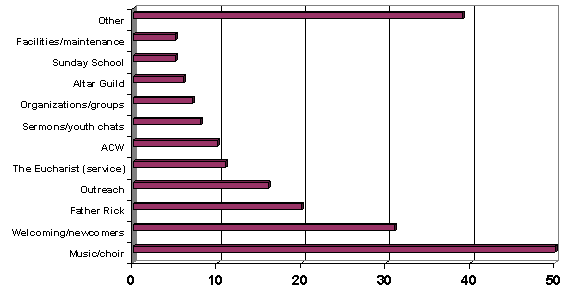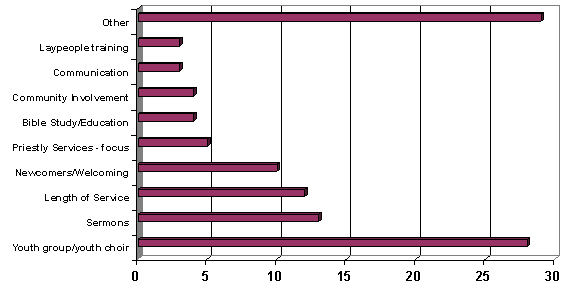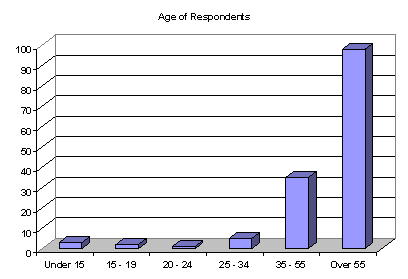 Parishioners
over 55 years of age account for 68% of survey respondents. The 35-55 age
categories represent 24%, or nearly one quarter, of our survey base.
Parishioners
over 55 years of age account for 68% of survey respondents. The 35-55 age
categories represent 24%, or nearly one quarter, of our survey base. Parish
Survey: Key Findings
October 2004
Table of Contents
On August 24,
2004, St. James Parish Council approved the formation of a small working group
(the Renewal Team) with the mandate of leading a long-term process of renewal.
The initial focus of the renewal process involves an examination of our
strengths and weaknesses form the perspective of the parishioners. The purpose
of such an assessment is to understand the various strengths and weaknesses of
parish life at St. James, so that we may leverage the former and correct the
latter.
Ultimately,
the goal of the Renewal Team is to produce a well-defined strategic plan for St.
James Manotick and to provide the appropriate guidance and focus for its various
ministries. Down the road, it is our intention, and hope, that successful
implementation of the strategic plan will result in the establishment of a
strong foundation for an ongoing stewardship campaign.
With this
objective in mind, In October 2004, a parish survey was conducted via mail-out
questionnaire to invite every individual (over 13 years old) on the St. James
parish list to reflect on the many ministries of St. James and to offer their
candid perceptions and feedback. Approximately 400 questionnaires were mailed to
240 households throughout the parish.
This report presents the key findings of the survey. For each area covered by the survey questionnaire, the quantitative findings are accompanied by a summary of qualitative inputs, based on an interpretation of all comments recorded for that particular area.
In total, 143
surveys were completed and returned to the St. James office on or before October
27, 2004, and are included in this analysis. The number of returns represents
approximately 36% of all parishioners, and as such constitutes a very healthy
response by the parish.
This section provides a reasonable profile of the St. James parish, by highlighting key parishioner demographics.
 Parishioners
over 55 years of age account for 68% of survey respondents. The 35-55 age
categories represent 24%, or nearly one quarter, of our survey base.
Parishioners
over 55 years of age account for 68% of survey respondents. The 35-55 age
categories represent 24%, or nearly one quarter, of our survey base.
At less than 8% of respondents, adults under 35 years of age are poorly represented here, especially young adults and teenagers. It is unclear whether these numbers are representative of the parish at large, or merely the result of a lack of interest in filling out questionnaires. It is likely a combination of both.
Nevertheless, the significant distribution of respondents across the 35-55 and over 55 age groups provides some insight into areas where perceptions about St. James are shared, and sheds light on areas where the church may need to address the contrasting values and expectations between adult groups at different life stages.
The chart
below shows the distribution of survey respondents according the number of years
they have been coming to St. James. You will note the close correlation between Years
at St. James and Age of Respondents.
As expected, most parishioners attending Sunday services on a weekly basis tend
to be over 55 years of age.
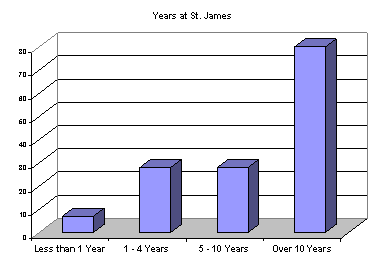
The survey results indicate that while younger adults and families make up a good portion of those attending for 4 years or less, parishioners of age 35-55, and especially over 55, still account for most of St. James newest recruits. These two charts underscore the need for St. James to attract and retain younger families.
St. James is
blessed with a substantial base of regular church goers.
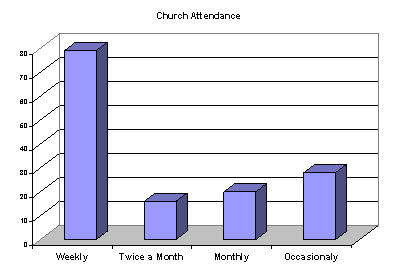 Of
the total, 55% of parishioners surveyed (or 79 out of 143) attend one of St.
James’ Sunday services on a weekly basis. While the chart seems to imply that
there is an opportunity to transition people from occasional
to monthly and eventually to weekly
attendance, the demographics behind the attendance behaviour do not necessarily
support this.
Of
the total, 55% of parishioners surveyed (or 79 out of 143) attend one of St.
James’ Sunday services on a weekly basis. While the chart seems to imply that
there is an opportunity to transition people from occasional
to monthly and eventually to weekly
attendance, the demographics behind the attendance behaviour do not necessarily
support this.
Of the 34% who attend once a month or less, the great majority are parishioners in the over 55 age category. Among this group, many have limited mobility or for reasons of failing health are not able to attend more frequently. Issues discussed later in this report, which are related to the need for more regular parish visitations, offer potential solutions to this situation.
Most respondents were willing to enter
the first half of their postal codes on their questionnaires, which allowed us
to identify where they live within the geography of the greater Ottawa
municipality.
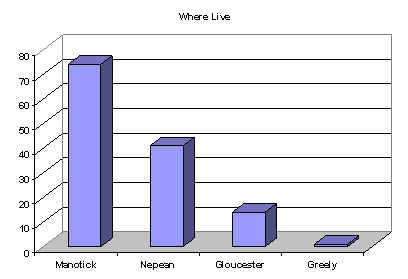
Manotick is home to 53% of survey respondents, as identified by the K4M postal code prefix.
Another
29% come in from Nepean, or more specifically, Barrhaven. It should be noted
that respondents included several prefixes (e.g. K2J, K2G, K2C, K2A), although
the vast majority emanate from K2J, or Barrhaven. A significant portion of
surveys (10%) came in from Gloucester. Responses were also received from Greely. We know from our parish list that several St. James
parishioners reside in nearby towns and villages such as Kars, North Gower and
Osgoode, however no questionnaires were returned from those areas.
The chart on
the left shows that 2/3 of all respondents were female. This is also reflected
in the participation level of parishioners in the various groups, ministries and
organizations at St. James.
While a
healthy 43% of respondents claim to be active (column on far right) in one or
more parish groups or parish activities, it should be noted that outside the
adult choir, most of these are indeed women.
The centre columns indicate strong loyalty to St. James Manotick with 94% stating that they do not attend another church on a regular basis, choosing to make it their place of worship.
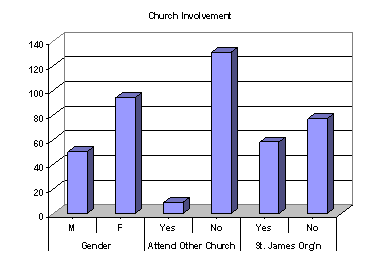
The 10:00AM
Sunday service is preferred by 82% of parishioners surveyed, while the 8:15AM
service is chosen by 18%. Among total respondents, nearly 15% also specify
Evensong as a preferred service at St. James – it should be noted that most of
the parishioner who regularly attend Evensong services are also regular
attendees of the 10:00AM Sunday service.
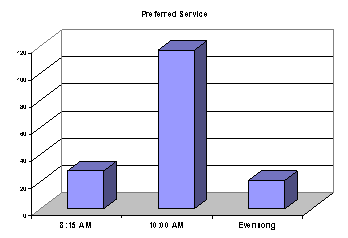
This chart
and the one above (i.e. Preferred Service) provide much the framework within
which most parishioners shape their perceptions and opinions of St. James.
Demographic profiling and attendance behaviour give us the necessary context for understanding how parishioners rate St. James in various areas and help in the interpretation of the comments they offer in support of their ratings.
The remaining sections in this report
are dedicated exclusively to the key findings of the survey. For purposes of
consistency and flow, the report follows the same order of topics as outlined in
the survey questionnaire.
The areas covered in this survey include:
· Worship – general, Eucharist, and other
· Education
· Fellowship
· Music
· Outreach
· Parish groups
· Parish activities
· Leadership and Operations
·
Strengths and weaknesses
For each area, the quantitative findings
are presented in graphical format showing awareness levels (where appropriate)
and average ratings for quality and importance. A scale of 1 (not important) to
5 (very important) was used consistently throughout the survey.
In every case, qualitative feedback is provided to support the ratings. The qualitative feedback is based on an interpretation of over 350 individual open-ended comments.
Here we asked respondents to provide ratings and comments on the more general aspects of worship at St. James. These include, but are not limited to, planning (e.g. worship committee), worship activities for children in church school, youth-oriented services for teens, opportunities to worship during the week, facilities for the disabled, and nursery facilities.
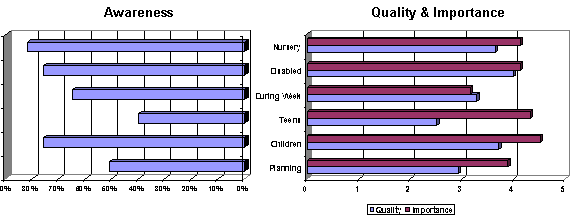
The chart on
the left shows the percentage of parishioners aware of each area. On the right
are the average ratings for each area in terms of quality and importance.
Higher
Awareness
· Disabled - Most are aware of improvements made to St. James facilities to accommodate the needs of the disabled – correspondingly, facilities for the disabled are favourably perceived.
· Nursery - Over 80% are aware of the nursery, overlooking the main floor at the back of the church. The average quality rating of 3.64 is a result of the divergent views regarding the actual location of the nursery and its impact on the quality of the service. Younger families tend to think of it as “kid-friendly”, while some of the older more conservative parishioners consider it a noisy intrusion on their time of worship.
·
Children
– St. James Church School enjoys a high awareness level, and is deemed to be
very important by most parishioners regardless of demographic groupings.
Lower Awareness
– In Need of Attention
· Planning – This particular area was a source of confusion for some. The low awareness rating reflects the fact that many respondents did not understand what was meant by “planning”. Among those who did see it as a mindful exercise to improve the value and quality of the liturgy at St. James, many/most considered it to be important but were not aware of it taking place.
·
Teens
– Youth-oriented services are not well-known at St. James, yet deemed to be
very important. Even those who claim to be aware, refer to them as something
“St. James used to have”. This
is reflected in the low quality/importance ratio. Phil Whittall’s popular
Monday Night Bible Study for the youth is not viewed as a St. James program, but
is seen as the type of high-quality activity St. James should be bringing to our
youth (especially teens).
This section
covers liturgical aspects of the Eucharist at St. James with particular emphasis
on the sermon and the Holy Communion. It
also provides valuable feedback from parishioners on other critical elements of
the worship experience, including how they are greeted as they enter the church,
the music performed by the choir and organist, the printed materials and text
which support the service, as well as the length of the service itself.
The Sunday service (8:15am or 10:00am) is the most important element of parish life at St. James, as indicated by the average importance ratings on the chart below. Correspondingly, it is also the area that generated the most comments and drew the strongest emotional response.
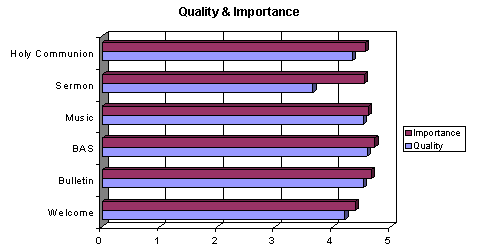
The chart
above shows the average ratings of quality and importance for elements of the
service specifically identified in the questionnaire. All elements were assigned
a high level of importance.
In most
instances, “quality” ratings tend to approximate “importance” ratings.
Overall, this indicates that St. James is a place or worship, and a type
of worship experience, that the great majority of parishioners find fulfilling.
Overall, the majority of parishioners tend to agree that:
The
open-ended comments in the survey provide critical insight into the overall
ratings. While the comments suggest that many respondents like the Sunday
service just the way it is, a significant portion of the parish community has
raised issues or concerns about specific aspects of the service that they feel
need to be addressed.
Key Focus Areas
In total, there were 49 comments made related to the Eucharist. These comments can be clustered into four key focus areas concerned with:
There were
“Other” comments referencing individual topics, which are dealt with
appropriately further on in the report.
The bar graph below shows the relative importance of the key focus areas expressed as a percentage of total comments related to the Eucharist. An analysis of the comments for each area reveals a strong sense of shared sentiment and perception among parishioners.
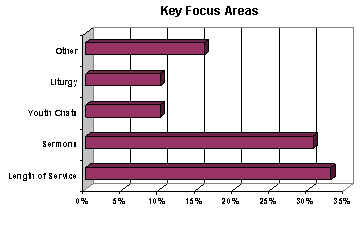
Length of
Service
The duration
of the 10:00AM Sunday service is identified as a problem by parishioners in all
age groups. Among those who prefer the 10:00AM service, most say that the length
of service is just right. However, a significant percentage believes it is too
long.
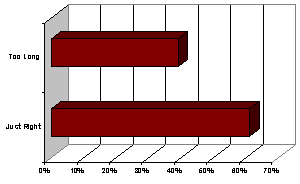
This bar
graph shows that while 61% are happy with the length of the service, 39% think
it should be shorter. In fact, many of those who say the length is “just
right” also comment that “sometimes” the service tends to “drag on”.
Comments
indicate that this perception is not necessarily associated with the liturgy as
prescribed by the Book of Alternative Services (B.A.S.), but rather is the
result of the way in which certain things are done at St. James.
The length of
the service is more likely to keep people away than attract them – for
example, some parishioners said:
“The length of the service is one reason I no
longer attend as regularly.”
“The length of the service should be 65-70 minutes
maximum. I would attend more often if this were the case.”
“With young kids, I would appreciate it if the
service could be closer to 60-75 minutes.”
Parishioners’ comments identify what they believe to be some of the specific causes of the perceived “unnecessarily long” services, and offer suggestions on how the situation might be improved. The most common are summarized below:
It is important to remember that 61% of survey respondents believe the length of service to be “just right”, most of the time. Typically, only those who are not satisfied tend to offer comments.
However, the
perceptions of 39% of respondents can not be ignored.
Since no one complains of the service running ‘too short’, there appears to be reasonable cause to consider shortening the average length of the 10:00AM service. Comments indicate a 60-70 minute service would be more enjoyable than one that lasts 90 minutes. The challenge, of course, lies in addressing the needs of the 39% without altering the favourable perceptions of the 61%.
The Sermon
The sermon
stands out as the area where the gap between quality and importance is the most
pronounced. With a quality rating of 3.6 out of 5, it is to be expected that the
sermon would account for nearly 1/3 of all comments related to the Eucharist.
The
open-ended comments by parishioners offer some explanation for the sermon’s
lower quality rating, and give advice on how this focal point of the service can
be improved.
Most comments
and suggestions related to the sermon fall into three areas. These are
summarized, as follows:
Youth Chats
Youth
chats or kids’ chats refer to that later segment of the service when Father
Rick asks “would our young people like to come up?”
There is no indication from the majority of respondents, who are
generally satisfied with all aspects of the service, on how they feel about
youth chats. The implication is that it is a positive aspect of the 10:00AM
service and contributes to the perception, particularly young families, that St.
James is a friendly and welcoming place for children.
The comments offered in the survey tend to reflect the opinions of older parishioners who view them as an unnecessary extension of a service they already perceive to be ‘too long’. The number of comments made warrants some mention, however, on the whole they are deemed to be the exception rather than the rule.
Liturgy
As
with ‘youth chats’, the number of comments is not sufficient to be
representative of the larger congregation, yet should be noted as potential
areas of concern for a limited number of parishioners.
Comments include:
· References to the Book of Common Prayer (BCP) as neglected and preferred to the Book of Alternative Services BAS).
· Resistance to anyone other than the minister offering the host at communion, and specific objection to youth ministering during the Eucharist.
· Large-print hymn books without music would be nice. (Note: parishioners need to be reminded regularly that such materials are available)
· Intercessions should accommodate individual concerns of parishioners without having to name so many people in the service bulletin.
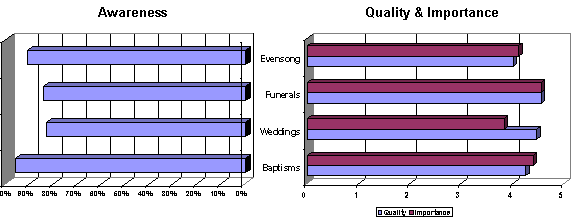
Respondents were asked to rate other worship-related services
at St. James. These include baptisms, weddings and funerals. Open-ended
references to Evensong were also included in this section of the survey.
Generally, parishioners a very aware that St. James performs such services and consider them to be integral to the Christian lifecycle. As expected, baptisms, weddings and funerals are perceived as highly important. Correspondingly, the average quality ratings are also high for these services and related ceremonies.
Few comments
were offered to help qualify the ratings. Following, is a brief summary of
available comments.
· Baptisms
o Some parishioners would like to know ahead of time if baptisms are to take place during Sunday service. On those occasions, they would prefer either not to attend, or to attend an alternative service (e.g. 8:15AM). They feel baptisms make the service too long
o Comments unrelated to the actual quality of the services per se convey a certain disapproval of families who come to St. James for baptisms, but never return to become regular active members of the parish. This sentiment is sometimes accompanied by a recommendation that St. James (lay people and clergy) need to follow-up with the families of the newly baptized and encourage them to participate more actively in the church.
·
Weddings
o
A few comments concerned disapproval of the
practice of booking weddings during Sunday service. If the practice is to
continue, these respondents would like fair warning, so that they can make
alternate plans.
·
Funerals
o The following comment needs no interpretation: “Father Rick showed himself to be caring and professional priest before and during our sad event. Very supportive!
Average awareness levels and quality/importance ratings were measured for education programs and activities directed at children, teens and adults. Church school, bible study, guest speakers and the Alpha course are the programs which are most commonly known.
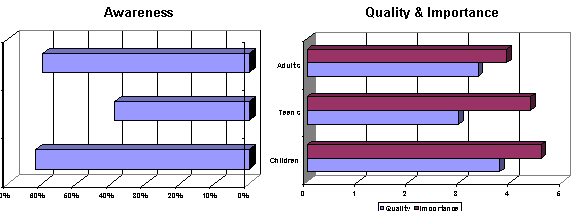
Awareness, Quality and Importance
The results
indicate that education in general is an area that is lacking at St. James. This
is true of education programs aimed at all age groups, with 60% of respondents
aware of adult programs and 62% aware of activities for children. However, the
lowest awareness levels recorded are for the teens, with only 39% of respondents
aware of any activities aimed at this important segment of the parish.
Respondents
place a very high level of importance on children and teens, yet assign a
significantly lower quality rating to those programs.
Very few
comments were offered by respondents in this section of the survey, which is
typical of low awareness areas. Therefore they should not be viewed as
representative. Nevertheless, the following provides some qualification of the
ratings:
Education for Children
– The growing number of children in the St. James Church School is a strong
indication that the program is popular and meeting some of the needs of most
young families in the parish. However, comments do suggest that the curriculum
might need some attention. The low quality rating also suggests that there is
room for improvement. There is an implication that learning about God should be
the primary objective of Church school, as opposed to acting as a daycare
service while parents worship upstairs.
Education for Teens
–As in others areas throughout the survey questionnaire, respondents are
saying that our youth, particularly the teens, are a neglected group within the
St. James community. Whether the topic is education, fellowship or the youth
choir, the perception is that ‘high importance’ is met with “low
quality”. The most common remarks point to the need for teen Bible study,
and/or a lack of it. Ironically, many if not most are aware of, and applaud,
Phil Whittall’s Monday Night Bible Study group for our youth. They hold it up
as a shining example of what Bible study is all about and what St. James should
be doing more of. Perhaps, this is because they consider it a personal
initiative of Phil’s, as opposed to a St. James program.
Education for Adults – Among the three age demographics, education programs aimed at adults received the lowest importance rating. It is not clear whether this average rating (3.9) is based on past Bible study groups or more recent efforts. However, the results do suggest that many adults believe that Bible study is a integral part of walking the Christian walk. Their comments indicate a preference for textual study of the Bible, as opposed to discussions of videos. They also express the need for Christian adults to be challenged intellectually and to discuss new concepts in theology as an ongoing part of our growth as Christians.
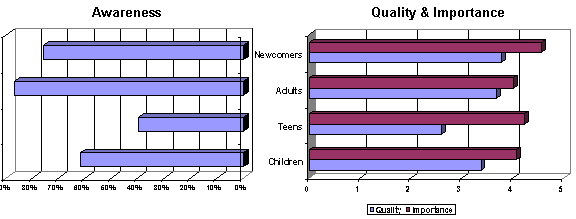
Fellowship activities for children, teens and adults are
considered to be very important by most parishioners. The bar graphs below
present the awareness levels and quality and importance ratings.
Teens - Here
again, teens are singled out as the group for whom there appear to be few
opportunities for fellowship. The poor quality rating for teen fellowship
activities is due in part to low awareness, but may also be a function of poor
attendance by teens at previous events. The survey results do not offer any
guidance in this regard, nor do they provide any indication of whether or not
the size of the teen community at St. James is at the root of the problem.
Adults -
Awareness levels and quality ratings for adult fellowship activities are both
quite healthy. That said, comments clearly express the need for more adult
fellowship opportunities outside of those organized and attended by specific
parish groups (e.g. the choir), since these are likely included in the ratings,
but not necessarily open to other parish members. Coffee time following the
Sunday 10:00AM service is often cited as the most frequent and convenient
fellowship venue, given that people are already at the church. Comments suggest
that attendance at this particular venue could be strengthened by a) shortening
the service, and b) making an effort to identify and accompany newcomers to
coffee time after the service.
Newcomers – The
findings regarding newcomers represent somewhat of a contradiction. On the one
hand, awareness and quality are both rated highly by respondents, including
newcomers themselves, yet, on the other hand, according to the comments, it is
an area where parishioners seem to think we do a poor, or ad hoc, job. Newcomer
satisfaction is perhaps incidental, despite what is considered by some to be an
uncoordinated welcoming program in need of greater enthusiasm and action.
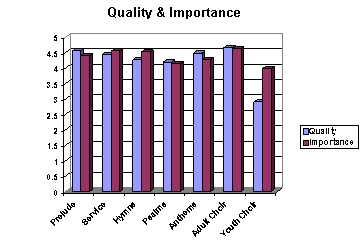 The
music at St. James is a pervasive presence in the larger 10:00AM Sunday service.
From the Processional Hymn to the Postlude and all the psalms, prayers and
responses in between, the music created by the adult choir at St. James in a
source of joy for most parishioners. It is sometimes stated as the reason some
people attend St. James. Some comment on its size and how professionally managed
it is – for a parish our size.
The
music at St. James is a pervasive presence in the larger 10:00AM Sunday service.
From the Processional Hymn to the Postlude and all the psalms, prayers and
responses in between, the music created by the adult choir at St. James in a
source of joy for most parishioners. It is sometimes stated as the reason some
people attend St. James. Some comment on its size and how professionally managed
it is – for a parish our size.
This chart
shows the quality and importance ratings for each of the various elements of the
service accompanied by choir music. Specifically, average ratings are provided
for the prelude/postludes, hymns, psalms, anthems and other service music. There
are also ratings for both the youth and adult choirs.
Perceptions
of music at St. James are very favourable among the vast majority of survey
respondents. The exception, of course, is the youth choir (on the far right of
the chart). Its low rating is due more to the lack of youth choir music to than
it is to the actual quality. Of the 20 or so comments offered in this section,
nearly half (45%) concern the youth choir. Another significant block of comments
strongly suggest that more words should be spoken rather than sung during the
service.
Youth Choir - generally,
the comments seem to lament the fact that we do not have a youth choir anymore.
They recommend ways to encourage our youth to join (e.g. scholarships) and
suggest that a youth choir might attract more youth to the church. This is yet
another area where we need to better understand whether the key issue is a low
youth participation or low youth population. Nevertheless, when our youth do
perform in front of the church (e.g. the young ladies who play the harp), these
are moments described as ‘wonderful”.
Spoken or Sung –
another third (roughly) of the comments dealt with a desire to reduce the amount
of music heard during the service in favour of the spoken word. Specifically,
there appears to be a significant portion of the congregation that would prefer
to ‘say’ the psalms and the Lord’s Prayer, for example. They feel more
active and participative in the service when they are able to respond without
singing. This sentiment is also echoed by some members of the choir.
Other – The remainder
of the comments touch on a two more topics. One is a concern over the focus
placed on the choir. The placement of the choir (front and centre) tends to add
to this perception. Some comment that the altar should be the focus. The other
is the exclusively traditional music performed at St. James. Some would like to
hear more contemporary music sung in the church.
The survey asked respondents to rate St. James, in terms of awareness, quality and importance, on predefined outreach categories. These include evangelism, charitable work, specific appeals, regular visits with parishioners and crisis visitations.
Awareness
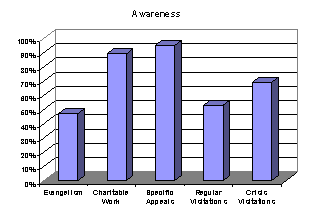
Respondents
are very aware of charitable work done in help of the needy, and even more so of
specific appeals at certain times of the year. These particular outreach
programs and activities are perceived to be highly important and of high
quality.
Also most respondents know about crisis visitations, which are usually made by Father Rick on extremely short notice to support parishioners in physical or emotional distress. This particular type of outreach, usually conducted by the priest, is perceived to be of the highest quality and importance. Comments suggest that Father Rick is always responsive, attentive and caring.
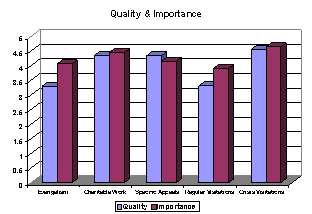
Quality
& Importance Evangelism – comments
tend to be acknowledgements of its importance. Yet, the ratings imply a lack of
understanding of the ways in which evangelism is carried out at St. James. Regular Visitations –
Comments are consistent with the low quality ratings. Invariably, these comments
highlight how important parishioners feel regular visits by the minister are,
and express – sometimes quite emotionally – their disappointment in not
being visited by someone from the church, either clergy or layperson. Specific
references are made to the need for hospital visits and visits to newcomers.
This type of outreach is seen as an outward move into the community, which will
ultimately bring more people into St. James, over time. One respondent
acknowledged the time, effort and resources required to support a serious
visitation program, and suggested that an Outreach Committee be formed by
members, each of whom would lead a specific outreach audience – e.g. sickness,
job loss, family problems, faith, etc.
Of the 135
respondents who answered the question, 58 (or 43%) belong to a St. James parish
group, or otherwise actively perform specific functions critical to the
efficient operation of the church. This
is not surprising given the size of some of the parish groups. For example, the
ACW and the adult Choir each have over 20 active members.
Awareness
levels for Craft Group, Men’s Group, Pastoral Care, and Ways & Means are
lower because the group is inactive, new and just starting, or struggling with
low participation among its members. A review of
comments related to parish groups highlights the following points: ACW – this is
perceived as doing excellent work and being very active on the fundraising
front. Comments indicate that there is confusion, or a lack of awareness,
surrounding the use of funds raised. The assumption by many people might be that
the funds go to St. James, when in fact they are administered by the ACW. Men’s Group – this
particular group is perceived as inactive. Yet the ratings suggest that it can
have a meaningful role to play at St. James. Other Groups – The
issue of ‘too few people to do the work’ is a recurring theme with groups or
committees dealing with Pastoral Care, Welcoming, Youth, Ways & Means,
property, and so on. It is suggested that the same people tend to volunteer
whenever there is a need and that there is insufficient interest to support and
grow all the traditional parish groups and committees at St. James. Some
respondents point to communication, or lack thereof, as the culprit. Communication – In
general, parishioners know of the parish groups and are aware of some of their
related efforts and activities. However, the comments reveal a need for regular
communication regarding the mission of each group, its membership, who to
contact, recruitment, etc. Communication is seen as an essential tool to share
information about parish groups and to invite greater participation from the
congregation. In this
survey, the awareness of various parish activities has focused on the more
visible and recurring ‘events’ staged throughout the year. Therefore the
average awareness levels captured here reflect only those major functions that
have become ‘traditions’ at St. James. They represent merely the tip of the
iceberg, so to speak, of all the activities undertaken throughout the year by
the key parish groups. This chart
The average
ratings for quality and awareness for these activities are not particularly
revealing (not shown here), since all have received high ratings with only minor
variances between them. What is
noteworthy, however, is how respondents perceive activities aimed at newcomers. Welcoming Newcomers -
Comments suggest that awareness levels and quality ratings are associated with
past activities as remembered by earlier newcomers to St. James. The open-ended
comments offered in this section also suggest that welcoming newcomers is an
area which is currently in neglect and in need of greater focus. Publicity & Communication
– Some respondents believe that awareness of parish activities and events, and
therefore of St. James, could be greater if an effort were made to promote
upcoming events with the local media, inviting them to attend and sending in
photos afterwards. A Publicity Committee, or Officer, could work with the
various parish groups to begin to project a more vibrant parish life at St.
James. This would also encourage the organizers of events to prepare and convey
the appropriate message regarding goals, objectives and beneficiaries of their
respective events. The areas covered in the last section of
the survey questionnaire are concerned with the management of St. James
Manotick, as a non-profit organization. As such, respondents were invited to
indicate whether or not they were aware of the specific management facets and to
assign a rating for quality and importance. The intent of this section is to
understand parishioners’ perceptions of how St. James is run, by asking them
to reflect on and comment on the priestly services delivered by Father Rick, the
vision and leadership provided by St. James Corporation and Parish Council, the
interaction of the leadership group with the parish, daily contact with the
Church, internal and external communications, as well as the maintenance and
upkeep of Church facilities.
Communications
-
Respondents are saying that communications, both internally and externally,
could be better. Internally, our communications create the perception that there
is a lack of leadership, vision and organization - as evidenced by the
announcements at the end of the Sunday service and previous comments to that
effect. Externally, there is a need to enhance St. James’ presence in the
community at large, to build awareness and encourage greater involvement by more
members of the congregation. Some of the comments point to the need to leverage
technology, for example, using our website for external communications, i.e.
posting notices; or the use of emails to distribute bulletins ahead of time. Openness
– Unfortunately, the few comments offered provide little insight into the
reasons for the poor quality rating. Perhaps,
respondents are implying a desire to see more fresh ideas adopted throughout all
church activities. Leadership
and Organization – There are scattered
references to the need for Father Rick to drive development in certain areas,
including youth ministry, family or contemporary services. As referenced earlier
in the ‘Eucharist” section, respondents feel Father Rick could be more
organized in his delivery of priestly services. Respondents were asked to list two
strengths and two weaknesses based on their overall assessment s of St. James
Manotick. In total, they named 208 strengths and 111 weaknesses. Given the
recurring mentions of some strengths and weaknesses, it was possible to group
many entries into one category or another. The charts below summarize
parishioners’ high-level assessment of St. James. Strengths and weaknesses are
listed in descending order according to the number of mentions each received. No
further analysis or interpretation is warranted, since respondents were not
asked to provide a rationale for their choices.
Strengths Weaknesses
However, evangelism and regular visitations, as
outreach categories, appear to suffer from low awareness and poor quality
perception (see chart below). A
handful of comments help to explain the evangelism ratings. However, it is
noteworthy that 50% (9/18) of all comments were focused on regular visitations.
3.7
Parish Groups
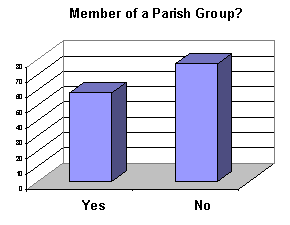 A
significant number of parishioners participate in one parish group or another.
Some are involved in two or more. As discussed earlier in this report,
parishioners tend to exhibit a high level of involvement in church groups and
activities.
A
significant number of parishioners participate in one parish group or another.
Some are involved in two or more. As discussed earlier in this report,
parishioners tend to exhibit a high level of involvement in church groups and
activities. 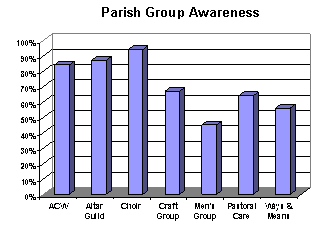 The
key parish groups, such as the ACW, the Choir and the Altar Guild enjoy fairly
high awareness levels among parishioners. The efforts of the Choir and the Altar
Guild are ‘front and centre’ every Sunday and their impact is clearly felt
and appreciated during the Eucharist. This is reflected in the awareness levels in the chart
below. The ACW’s awareness level
is the result of the visibility and success of the traditional events it
organizes in support of outreach, fundraising and fellowship.
The
key parish groups, such as the ACW, the Choir and the Altar Guild enjoy fairly
high awareness levels among parishioners. The efforts of the Choir and the Altar
Guild are ‘front and centre’ every Sunday and their impact is clearly felt
and appreciated during the Eucharist. This is reflected in the awareness levels in the chart
below. The ACW’s awareness level
is the result of the visibility and success of the traditional events it
organizes in support of outreach, fundraising and fellowship.
3.8
Parish Activities
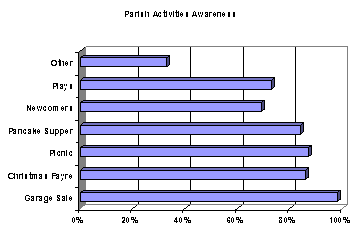 shows that most parishioners are aware of key events like the garage sale, the
Christmas Fayre, the Church Picnic and the Pancake Supper.
shows that most parishioners are aware of key events like the garage sale, the
Christmas Fayre, the Church Picnic and the Pancake Supper. 3.9
Leadership & Operations
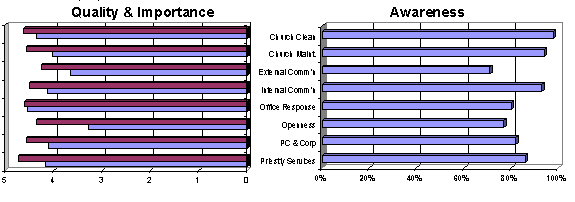
The bar charts
above shows ‘quality and importance’ on the left and ‘awareness’ levels
on the right. Generally, respondents rate St. James quite favourably on most
fronts. However, the chart also indicates that there are two areas where
potential improvements in both awareness and quality should be considered –
i.e. internal communications and openness to new ideas.3.10
Strengths and Weaknesses
